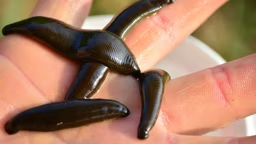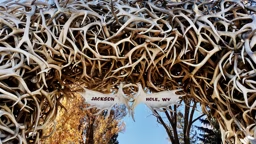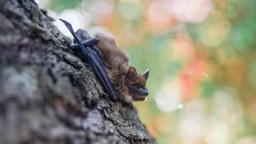The chipmunk zipped across the path like a blur. The next thing I knew, my golden retriever was looking at me proudly — with a tail sticking out of the side of his mouth. In horror, I commanded, “drop it.” He obediently opened his mouth, and the rigid chipmunk hopped out and streaked away.
Although this was the first time my dog had actually snared a chipmunk, the chase scene was fairly typical of our woodland walks. Dogs hunt and animals run, right? Well, not always. There are some animals — namely skunks, porcupines and bees – that, if cornered, will strike back.
Making a Stink
Skunks sport that big white stripe down their backs for a reason. It is a classic example of aposematic coloring — distinctive coloration or patterns that signal to a potential predator, “WATCH OUT!” Unfortunately, dogs aren’t born with an understanding of warning coloration, so it often takes at least one nasty encounter to learn a lesson.
Skunk odor can travel as far as 20 miles and is made up of two groups of chemical compounds: sulfur and hydrogen bonds that produce the odor, and an acetyl group (a vinegary smell) that enhances the pungent odor when it reacts with water (as in a wet dog, long after you thought you got rid of the skunk smell).
Using that knowledge, the best way to counteract skunk perfume is to scrub your dog with a combination of hydrogen peroxide, baking soda and dish soap, which reduces the odor by oxidizing the hydrogen/sulfur compounds.
If it’s late at night, you’re out in cabin country and you’re desperate, a concoction of vinegar and water (2/3 cup water, 1/3 cup vinegar — even if it is balsamic!) works well enough to get you through the evening. Can you detect the voice of experience? My golden smelled a little like a salad, but it sure was better than the alternative.
Puppy Pincushion
Porcupines are dark brownish with a black line that runs down the lower back to the tail. Quills extend from their heads to their tails, and quills on the black area are tipped with white. At night, the white quills on the black markings stand out as a form of aposematic coloring, warning a would-be attacker.
When pursued, a porcupine first heads for the nearest tree, then chatters its teeth in warning. If all else fails, a porcupine erects its quills and swipes the predator with its tail, driving quills into its attacker. The quills, which are designed to embed in the tissues of the porcupine’s assailant, have a sharp tip with scale-like, microscopic barbs and are filled with a spongy core that expands when it fills with blood. Thus, it is important to remove quills from your dog as soon as possible.
If your dog has only a few quills, and there are none in its mouth, throat or eyes, you can remove the quills on your own with a pair of pliers. The first thing you should do is cut the upper tip of the expanded quill to see if it will deflate some and make removal easier (or less painful).
One woman I know, hiking in the backwoods with her dog, resorted to biting the exposed tip of the quill to ease the extraction process. Left untreated, embedded quills can cause festering and other medical complications as they work their way into their attacker’s tissues.
If your dog has a face or body full of quills, it is best to seek the help of a veterinarian, who may have to use an anesthetic to remove them.
Yellow and Black Attack
Your dog doesn’t have to be walking in the woods or sniffing around the deck at twilight to encounter the tiniest of cabin nemeses: bees. What you should do depends on whether your dog has been stung once or has had the misfortune of encountering a nest or hive.
Like porcupine quills, bee stingers are barbed, which assist in their penetration into the skin. If you can locate the stinger, try to remove it without putting pressure on the venom sac (located just above the stinger). Since the venom in bee stings is acidic, apply a baking soda and water paste to the area and a cool compress to minimize swelling. Wasp stings on the other hand are alkali and are best treated with vinegar and a cool compress.
Some dogs, like humans, may have an allergic reaction to bees, which requires immediate veterinary attention. When my 4-month-old puppy got stung on the face at our cottage, his face swelled up and his eyes puffed shut — and it was off to the veterinarian. Since that time, I keep a good eye on him around bees and always have a supply of Benadryl on hand.
Sooner or later curious dogs will stumble upon a skunk, a porcupine or an angry bee. And it may happen when you least expect it — my dog’s worst skunk encounter occurred on the back deck at the home of some city friends, after all the stores were closed. Thankfully my friends had some vinegar in their cabinets, but it was still one LONG ride home.
Defeat Skunk Stink
Back by popular demand, here is one of the best de-skunking recipes around (previously featured in the Feb 2007 issue). Many recipes can be found on the Internet, but this one definitely works! The purpose of the dish soap is to break down the oil in the skunk spray.
1 pint hydrogen peroxide
2/3 cup baking soda
1 tablespoon dish soap
1. Combine ingredients in a plastic bucket.
2. Wash the pet (or person!) thoroughly.
3. Leave solution on for about five minutes (be sure to keep it out of eyes).
4. You’ll probably need to repeat several times, so these are good ingredients to have on hand!
Nancy Cain is the owner of Chester, a headstrong, 7-month-old golden retriever. So far, his worst nemesis is mushrooms, which he gobbles up with impunity.










